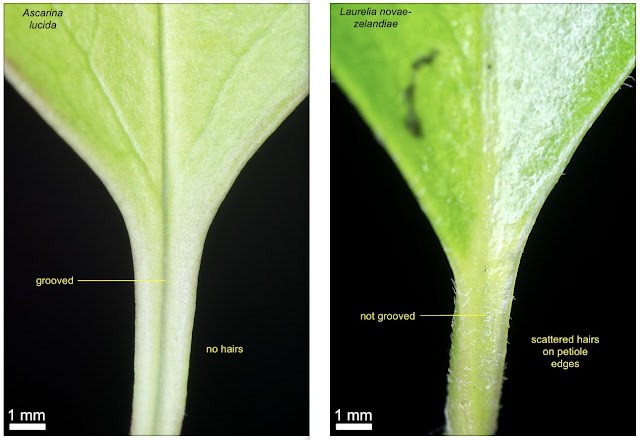Disclaimer: the following is not medical advice. It's just a description of what I started doing for my hay fever last summer. And it's not research based: there's no control and the sample size is n = 1.
I guess botanists suffer from hay fever at about the same rate as any other profession, but being allergic to your job is always good for a laugh, at least for other people. I suffer pretty badly from hay fever, mostly in November, December, and the first half of January. Allergy skin testing shows I'm very strongly allergic to cocksfoot (
Dactylis glomerata), quite strongly to some other grasses like timothy and ryegrass, and mildly to plantain and some tree pollens.
Cocksfoot produces masses of pollen from those large pink anthers.
Over the years, medications have improved. The first I used (mid 1960s) were Polaramine 2 mg, little pink pills that were very effective, but they made me drowsy. I've tried lots of others as they came onto the market and most have been pretty good. But for the last ten years or so, after some nasty side-effects, I've avoided pills altogether and instead used a combination of nasal spray and eye drops to topically treat the symptoms. That's been very effective. However, about five years ago pharmacists started warning me against continuous use of the eye drops. Apparently continued use of anti-histamines can worsen symptoms of prostate enlargement in men with benign prostate hyperplasia (i.e., many men my age). I've also tried the desensitisation injections, but it was tedious and only lasted a few years.
So last year I had a bit of a think. I realised that my main allergen, cocksfoot, starts flowering several weeks before I get my first hay fever symptoms. It seems a bit of pollen in the air isn't enough to set my hay fever off. It's only when levels get really high—peak flowering—that I succumb to that debilitating itching and sneezing and sometimes even to skin rashes. Also it also doesn't start as soon as I go outside; it usually takes at least 15-30 minutes, often a lot more, to kick in. And it's worse at certain times of the day.
I assume that pollen settles in the film of tears on my eyes, and blinking concentrates it along my eyelids; once enough has built up there, it starts to generate a noticeable allergic response. So, I wondered, what if I could simply wash it away? How quickly would it accumulate again? I bought a bottle of a proprietary eye wash, mostly just to get the little plastic eye-wash cup that came with it.
Washing my eyes a couple of times a day seems to be enough to prevent them from itching, except when I'm outside during peak cocksfoot flowering; then it can be necessary every 30–60 minutes. It doesn't even have to be the commercial eye wash, just clean water works fine too. With hindsight, I remembered I don't get hay fever for a while after swimming.
After a bit of experimenting, I found that opening my eyes under the stream of water in the shower does the job pretty well and lasts all day for much of the hay fever season. I cup my hands under each eye and fill the space with water, then blink and roll my eyes up and down and right and left a few times. Lately I've been comfortable just opening my eyes under the stream of water (I turn the temperature down a little).
I spend most of my time in the Wellington city and suburbs, where there is a lot less flowering grass than in the countryside. When I'm outside doing field work, I carry a small bottle of tap water, an eye wash cup, and a small towel, so I can stop and rinse my eyes whenever I need to. It's no more uncomfortable than opening your eyes when swimming underwater.
Itchy eyes are my main hay fever symptom, but I can also get a runny nose. I found I could learn to tolerate rinsing my nasal passages in the shower too, and that gives good relief. But mostly just washing my eyes
seems also to prevent the worst of the runny nose and sneezing.
Rarely, if I'm out on a sunny hot day, I can have a pretty extreme rash and even swelling, wherever my skin comes into contact with pollen. That's a photosensitive dermatitis, caused by a combination of pollen, sweat, and sunlight. To protect my skin, I just wear long trousers and long-sleeved shirts.
Last summer, and again this year, I used this regime and I didn't need any drugs at all. I had a bit of hay fever, but nothing too uncomfortable. As long as I had some water and my eye wash cup with me, I found I could very quickly put an end to itchy eyes (the itchiness disappeared almost instantly after washing). My hope is I'll never need hay fever drugs again.
I repeat: this is not medical advice. It might not work for you. There might be risks I haven't thought of. But I thought I had nothing to lose in giving it a try. It's probably safest to use distilled water or clean saline solution; a proprietary eye wash would be even better. If you use warm shower or tap water, you'd want to be sure the hot has been heated sufficiently to sterilise it (otherwise
legionnaire's disease might be a risk).
If you do try it, it's at your own risk, but please post a comment and let me and others know if it helps, or not. I'd also welcome comments from medical professionals, because I might be overlooking something important. I did discuss it briefly with my doctor; he looked skeptical and slightly disapproving, but didn't give any particular advice.





























